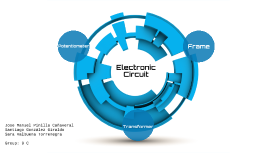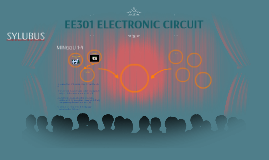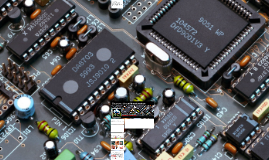EE301 ELECTRONIC CIRCUIT
Transcript: OPERATIONAL AMPLIFIER Upon completion of this course, students should be able to: 1. Explain correctly the principles of electronic circuits by using block diagram or circuit schematic. (C4) 2. Conduct the construction of electronic circuits application during practical works based on the theory and principle operation of the circuits. (P4) 3. Deliver an oral presentation to display good communication skills. (A2) Filter Transformer: used to step the input AC voltage level up or down consists of two winding called the primary and secondary. the input to the transformer is applied to the primary and the output is taken from the secondary. operates based on the transformer ratio also known as the turns ratio of the component. the turns ratio of a transformer is equal to the voltage ratio of the component Example: A transformer with a turns ratio of 10 to 1, convert the 120V 60Hz sine wave input into a 12V sine wave. three types of transformer: i. step up transformer ii. step down transformer iii. isolation transformer OSCILLATOR LINEAR DC POWER SUPPLY RECTIFIER : Application of diode as: Constant Voltage Divider Circuit Rectifier R2 TIMER R1 A source of electric power (voltage and current) to operate electronic circuits. The most common source of energy for electronic circuits is obtained by converting the electrical energy available in the conventional alternating current (AC) electric power mains to an appropriate voltage or current. Examples: batteries, mechanically driven generators, photovoltaic (solar) cells, and fuel cells. VR1 Voltage Divider: Transformer MINGGU 1-4 80V 40V DC Power Supply Unit Block Diagram Variable Voltage Divider Circuit AC input R3 R1 Regulator COURSE LEARNING OUTCOME 0 - 40V Voltage Regulator Circuit Transformer SYLUBUS AC input Upon completion of this course, students should be able to: 1. Explain correctly the principles of electronic circuits by using block diagram or circuit schematic. (C4) 2. Conduct the construction of electronic circuits application during practical works based on the theory and principle operation of the circuits. (P4) 3. Deliver an oral presentation to display good communication skills. (A2) 80V Forward biased: during "positive" half cycle of the AC sine wave, the diode is forward biased as the anode is positive with respect to the cathode resulting in current flowing through the diode. since the DC load is resistive (resistor, R), the current flowing in the load resistor is proportional to the voltage (Ohm´s Law), and the voltage across the load resistor will be the same as the supply voltage, Vs (minus Vf), that is the "DC" voltage across the load is sinusoidal for the first half cycle only so Vout = Vs. 20V HALF-WAVE RECTIFIER OPERATIONS EE301 ELECTRONIC CIRCUIT Voltage Regulator circuit Voltage Divider DC Power Supply Voltage Divider

















